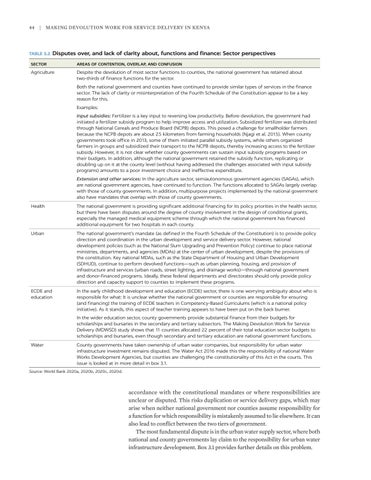44
|
Making Devolution Work for Service Delivery in Kenya
TABLE 3.2
Disputes over, and lack of clarity about, functions and finance: Sector perspectives
SECTOR
AREAS OF CONTENTION, OVERLAP, AND CONFUSION
Agriculture
Despite the devolution of most sector functions to counties, the national government has retained about two-thirds of finance functions for the sector. Both the national government and counties have continued to provide similar types of services in the finance sector. The lack of clarity or misinterpretation of the Fourth Schedule of the Constitution appear to be a key reason for this. Examples: Input subsidies: Fertilizer is a key input to reversing low productivity. Before devolution, the government had initiated a fertilizer subsidy program to help improve access and utilization. Subsidized fertilizer was distributed through National Cereals and Produce Board (NCPB) depots. This posed a challenge for smallholder farmers because the NCPB depots are about 25 kilometers from farming households (Njagi et al. 2015). When county governments took office in 2013, some of them initiated parallel subsidy systems, while others organized farmers in groups and subsidized their transport to the NCPB depots, thereby increasing access to the fertilizer subsidy. However, it is not clear whether county governments can sustain input subsidy programs based on their budgets. In addition, although the national government retained the subsidy function, replicating or doubling up on it at the county level (without having addressed the challenges associated with input subsidy programs) amounts to a poor investment choice and ineffective expenditure. Extension and other services: In the agriculture sector, semiautonomous government agencies (SAGAs), which are national government agencies, have continued to function. The functions allocated to SAGAs largely overlap with those of county governments. In addition, multipurpose projects implemented by the national government also have mandates that overlap with those of county governments.
Health
The national government is providing significant additional financing for its policy priorities in the health sector, but there have been disputes around the degree of county involvement in the design of conditional grants, especially the managed medical equipment scheme through which the national government has financed additional equipment for two hospitals in each county.
Urban
The national government’s mandate (as defined in the Fourth Schedule of the Constitution) is to provide policy direction and coordination in the urban development and service delivery sector. However, national development policies (such as the National Slum Upgrading and Prevention Policy) continue to place national ministries, departments, and agencies (MDAs) at the center of urban development, despite the provisions of the constitution. Key national MDAs, such as the State Department of Housing and Urban Development (SDHUD), continue to perform devolved functions—such as urban planning, housing, and provision of infrastructure and services (urban roads, street lighting, and drainage works)—through national government and donor-financed programs. Ideally, these federal departments and directorates should only provide policy direction and capacity support to counties to implement these programs.
ECDE and education
In the early childhood development and education (ECDE) sector, there is one worrying ambiguity about who is responsible for what: It is unclear whether the national government or counties are responsible for ensuring (and financing) the training of ECDE teachers in Competency-Based Curriculums (which is a national policy initiative). As it stands, this aspect of teacher training appears to have been put on the back burner. In the wider education sector, county governments provide substantial finance from their budgets for scholarships and bursaries in the secondary and tertiary subsectors. The Making Devolution Work for Service Delivery (MDWSD) study shows that 11 counties allocated 22 percent of their total education sector budgets to scholarships and bursaries, even though secondary and tertiary education are national government functions.
Water
County governments have taken ownership of urban water companies, but responsibility for urban water infrastructure investment remains disputed. The Water Act 2016 made this the responsibility of national Water Works Development Agencies, but counties are challenging the constitutionality of this Act in the courts. This issue is looked at in more detail in box 3.1.
Source: World Bank 2020a, 2020b, 2020c, 2020d.
accordance with the constitutional mandates or where responsibilities are unclear or disputed. This risks duplication or service delivery gaps, which may arise when neither national government nor counties assume responsibility for a function for which responsibility is mistakenly assumed to lie elsewhere. It can also lead to conflict between the two tiers of government. The most fundamental dispute is in the urban water supply sector, where both national and county governments lay claim to the responsibility for urban water infrastructure development. Box 3.1 provides further details on this problem.


